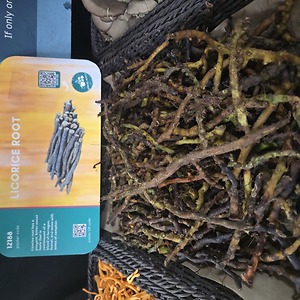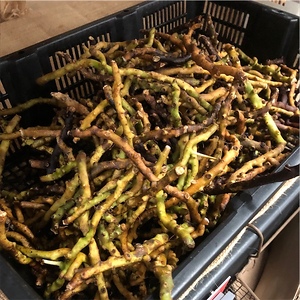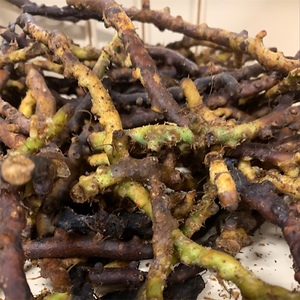


Licorice Roots
Estimated Inventory, ea : 0
Description/Taste
Licorice roots are slender and straight, growing horizontally from the plant, and can be considerably branched, sometimes extending over one meter in length. The long, cylindrical roots are brown, grooved, and rough with a wrinkled, woody appearance. When the outer layers are removed, it exposes a fibrous, yellow flesh, which is what gives the root its famous flavor. Licorice root has a pungent, bitter-sweet taste that is reminiscent of a blend of tarragon, fennel, and anise with notes of camphor.
Seasons/Availability
Licorice root is available year-round, with a peak season in the fall.
Current Facts
Licorice root, botanically classified as Glycyrrhiza glabra, is the underground stolon of an herbaceous, fern-like plant that belongs to the Fabaceae or legume family. Also known as Sweet Root, Gan Zoa in Chinese, Liquorice in British English, and Sweetwort, the name Licorice comes from the French word ‘licoresse’ and the ancient Greek word ‘glukurrhiza’ both meaning “sweet root.” Licorice root is predominately harvested when the plants have reached 3-4 years in age, and the roots are then dried for long term storage. Often found bundled in small bunches, ground into a powder, or in capsule form, dried Licorice root has been used as a medicinal ingredient for thousands of years in natural medicines and is also used as a flavoring agent for desserts and candies.
Nutritional Value
Licorice root is high in a compound called glycyrrhizin, which is believed to be fifty times sweeter than sugar and gives the root its sweet taste. It also contains manganese, phosphorus, amino acids, flavonoids, and some B vitamins.
Applications
Licorice root is mainly used as a medicinal aid or flavoring agent and can be found in liquid, dried, or powdered form in capsules and pills. The root is used to flavor beverages such as root beer and other soft drinks, liquors, and teas. It is also used as a foaming agent and flavoring in beer. In addition to beverages, the sweet root is used to flavor confections, baked goods, candies, and gum. Licorice root can also be used fresh and chewed as a breath freshener. In the 1930s and early 1940s in the United States, pieces of Licorice root were sold at ten cent stores for children to chew on like gum. In addition to edible uses, Licorice root is sometimes used in non-edible items, such as compost for growing mushrooms, shoe polish, and soap, as well as fire extinguishing agents. When dried, Licorice root will keep up to one year when stored in a cool, dry, and dark place.
Ethnic/Cultural Info
In traditional Chinese medicine, Licorice root is one of the most utilized medicinal ingredients, and there are over five thousand herbal remedies that use the root as a flavoring agent, aid, and supplement. Licorice root is used to treat stomach ailments, heartburn, and coughs, and to treat psoriasis and other skin ailments. The Egyptians also used it in a sweet drink known as mai-sus. Many bundles of the dried root were found in King Tutankhamen’s tomb in the belief that the king would make the drink in the afterlife.
Geography/History
Licorice root is native to southern Europe, the Mediterranean, and parts of Asia where it grows wild and has been cultivated since ancient times. Recorded use of Licorice dates back over three thousand years ago to writings on Assyrian tablets and Egyptian papyri. Today Licorice root is cultivated for commercial use and is grown in Italy, Spain, Germany, France, Turkey, Syria, Southern Russia, and China. It is also grown in select regions of the United States and is available in dried form through many online retailers and specialty grocers for worldwide distribution.
Recipe Ideas
Recipes that include Licorice Roots. One
| Food 52 |
|
Licorice Root and Malt Beer Beef Stew |
| Live Strong |
|
Licorice Root Tea |
| Good Food |
|
Clear Black Chicken Soup with Ginseng and Licorice |










